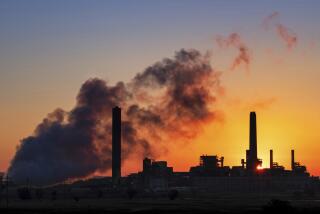Groups Appeal Rule on Plant Emissions
WASHINGTON — Environmental groups filed a petition with a federal appeals court and the Environmental Protection Agency on Tuesday, seeking to overturn a federal rule intended to spare many wood product plants from strict pollution controls, saying the regulation does not adequately protect public health.
In a 77-page petition filed with the EPA, the Natural Resources Defense Council said the rule disregarded the latest health warnings on formaldehyde, a carcinogen emitted during the manufacturing of plywood and other timber products.
Further, the environmental groups said the EPA rule, which in effect exempts so-called low-risk plants from regulation, runs contrary to the intent of the Clean Air Act and is a giveaway to industry. The petition asks for an immediate stay of the rule, which the EPA issued in February.
EPA spokeswoman Cynthia Bergman said the agency would review the petition, but she defended the rule as a “significant step forward.” She said it would cover about 220 facilities and reduce emissions of toxic substances, including formaldehyde, by 6,600 to 11,000 tons a year, or 35% to 58% below 1997 levels.
The appellate court is likely to take up the issue after the agency deals with it.
The petition maintains that the EPA developed its criteria for designating “low-risk” plants carelessly, ignoring the cumulative effect of multiple pollutants in a single area and failing to give the public a chance to review the calculations used to determine whether a plant would be exempted from strict new pollution controls.
The idea of a low-risk exemption from rules on air toxins was suggested by the wood products industry and could save it as much as $66 million a year for about 10 years in potential emission control costs.
The environmental groups said the EPA’s decision was one of its most serious blunders.
“This rule marks an environmental low for the Bush administration,” said James Pew, an attorney with Earthjustice, a nonprofit environmental law firm representing the Sierra Club in the court case. “The rule is really an attempt to overturn the Clean Air Act’s toxic-emissions provisions.”
The Clean Air Act was amended in 1990 to require that large industrial plants reduce emissions of 189 toxic substances using the best available technology. The amendment’s congressional authors said at the time that the new requirements were necessary because -- in the 20 years after enactment of the law -- very few toxic substances had been regulated because of protracted disputes over how to measure health risks.
As a result, Congress adopted a “maximum achievable control technology” standard to force improvements and avoid debates over risk.
Portions of the complaint filed with the EPA cite information disclosed by The Times in a May 21 article about the rule and the timber products industry’s role in drafting it. The Times reported that Bush administration officials had pushed aside health data on the risks of formaldehyde and relied on a risk assessment generated by a think tank that is funded chiefly by the industry.
In Tuesday’s filing, petitioners asked the EPA to roll back the rule because “the risk-based approach ... is simply unlawful.”
The petition asks for reconsideration of the rule based on such factors as the EPA’s alleged failure to consider new dangers of formaldehyde and the agency’s decision to proceed despite internal data indicating that public health would be improved without the exemptions.
“This rule is one of the worst I’ve seen,” said Eric Schaeffer, director of the Environmental Integrity Project, a petitioner in the case. “In their rush to get something out to meet their ideological needs, they got terribly careless.”
Shortly before the plywood exemption rule became final in February, the National Cancer Institute and the National Institute of Occupational Safety and Health disclosed new studies showing that exposure to formaldehyde might cause leukemia in humans.
However, the EPA rule did not mention the possible link to leukemia. Instead, it adopted a standard for exposure based on a cancer risk model developed by the industry-funded institute. That assessment is about 10,000 times less stringent than the level previously used by the EPA in setting standards for formaldehyde exposure.
“EPA must reconsider its assessment,” the petitioners wrote Tuesday. “EPA’s approach is simply irresponsible and unreasonable in view of these” new studies.
In defending the exemption last spring, the EPA’s top air regulator, Jeffrey R. Holmstead, said such regulations could not be delayed because of new studies but rather had to be based on “the best available science.” White House and EPA officials said the two new leukemia studies and a third in Britain appeared contradictory and were not thoroughly reviewed.
In early June, a group of international scientists gathered in France to consider the latest data on formaldehyde. They concluded that the new studies from the U.S. warranted upgrading the risk of formaldehyde from being classified as a probable carcinogen to a compound that is “carcinogenic to humans.”
More to Read
Inside the business of entertainment
The Wide Shot brings you news, analysis and insights on everything from streaming wars to production — and what it all means for the future.
You may occasionally receive promotional content from the Los Angeles Times.










